 Photo: Getty Images
Photo: Getty Images
Staying hydrated during the summer should be our number one priority, but empowhered women must do so in a smart and informed fashion! Although reaching for a bottle of water is often the most convenient, is it the most healthy? Is it safe?
In the last few years, there seems to be more and more controversy about plastic. Other than the environmental concerns, there are a variety of health concerns and simply knowing the facts about plastics can help you make an informed decision about what is safe and healthy.
PET, HDPE, LDPE, PS, PP. This alphabet of abbreviations make up some of the chemicals that are found in the mysterious plastic products we so often eat and drink out of. To simplify things a bit (and simultaneously complicate them) let’s organize plastics by their designated numbers and learn a bit about each:
#1: Polyethylene Terephthalate (PET, PETE): Clear, sturdy & shatterproof. Used for bottles of water, juice, etc. Generally regarded as safe.
#2: High-Density Polyethylene (HDPE): Used for bottles of water, juice, milk, and hygienic supplies. Generally regarded as safe.
#3: Polyvinyl Chloride (PVC, vinyl): Can be rigid or soft plastic. Used in shrink wrap, medical bags, shower curtains. Poses a threat to environmental and individual health safety. NOT SAFE.
#4: Low-Density Polyethylene (LDPE): Used for extra flexible plastic like plastic bags, garbage bags, some toys, and packaging. Generally regarded as safe.
#5: Polypropylene (PP): Known for its high melting point and used for many food bottles like catsup, yogurt, take-out meals. Generally safe.
#6: Polystyrene (PS): Rigid or foam form. Used for foam in furniture, food packaging and containers. NOT SAFE.
#7: This category of plastic is the “other” category, which is generally regarded as UNSAFE.
Facts:
1) Numbers 3,6 and 7 are not regarded as safe and should not be used as food containers. Check the bottom of your plastics to find out what kind it is.
2) Although FDA standards state that many of these plastics are safe, numerous studies have found that most of the plastics that have been declared as “safe,” often leach Bisphenol A (BPA)!
3) BPA is an estrogen-imitating chemical that is found in a majority of the plastics we use. BPA has been shown to cause health problems including, but not limited to decreased sperm count, fertility problems, cancer, and obesity.
4) As always, children are more sensitive to hazardous and poisonous materials than adults, so try to take extra care when handling plastic items for them.
5) It is important to remember that if you are going to use plastic in the microwave, to use only those that specify heat and microwave safety, as the most amount of chemicals leach with heat.
6) Oftentimes, grocery stores put plastic water bottles outside (in the sun) for advertising purposes so the summer is the most important time to be aware of exactly where our plastics come from and what they contain.
In all aspects of our consumerism and health, it is important to remain as informed and aware as possible! Do your own research, and explore the safety of the tap water in your city, as it may end up being safer than the store-bought stuff. Learn from this entertaining and informational resource!
Consider hopping on the eco-friendly aluminum water bottle wagon and take a small step in creating a healthier environment, a healthier wallet, and a healthier you!
Sources:
Plastic Water Bottles: Is "BPA-free" the Same as Safe? Natural Resources Defense Council. Retrieved August 11, 2011 from http://www.nrdc.org/thisgreenlife/0902.asp
BPA leaches from 'safe' products. Journal Sentinel Online. Retrieved August 11, 2011 from
http://www.jsonline.com/watchdog/watchdogreports/34532034.html
Plastic. MedicineNet. Retrieved August 11, 2011 from http://www.medicinenet.com/plastic/article.htm
In Feast of Data on BPA Plastic, No Final Answer. The New York Times. Retrieved August 11, 2011
from http://www.nytimes.com/2010/09/07/science/07bpa.html
This Everyday "Healthy" Beverage Poisons Your Body One Swallow at a Time. Mercola.com. Retrieved August 11, 2011 from http://articles.mercola.com/sites/articles/archive/2011/01/15/dangers-of-drinking-water-from-a-plastic-bottle.aspx
The Story of Bottled Water. TheStoryofStuff.org. Retrieved August 11, 2011 from http://storyofstuff.org/bottledwater
Reviewed August 17, 2011
by Michele Blacksberg R.N.
Edited by Jody Smith





Add a CommentComments
There are no comments yet. Be the first one and get the conversation started!